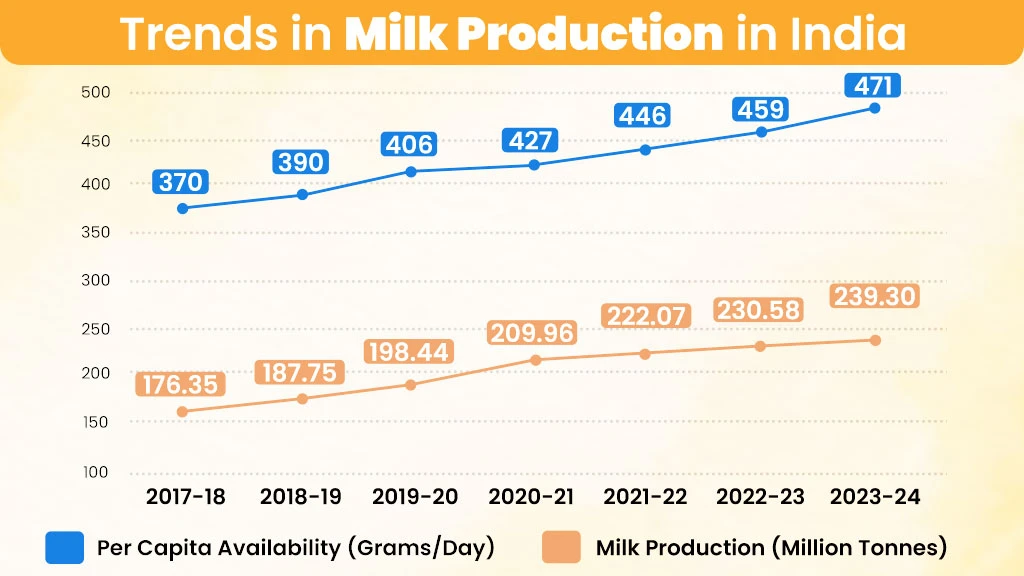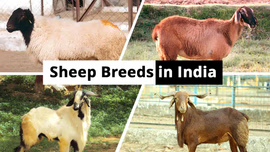The Journey of Milk Production in India

Table of Contents
- Introduction
- What is the History of Milk Production in India?
- What is the Present Status of Milk Production in India?
- What are the Factors Responsible for High Milk Production in India?
- What are the Government Initiatives for Milk Production?
- What are the Challenges and the Way Forward?
Introduction
The dairy sector in India has a vital role in boosting the Indian economy and socio-economic development of rural households. India is the largest milk producing country. Dairy farming in India is a highly attractive income source for millions of rural families. It employs a huge population of small and marginal farmers who are dependent on it for their livelihood.
What is the History of Milk Production in India?
India was a milk-deficit country during the 1950s and 1960s. There was negative annual production growth for many years, and a huge reliance on imports. The survival of the Indian dairy industry was tough. The annual milk production stood below 21 million tonnes by 1970, even though India had the highest cattle population globally.
The National Dairy Development Board (NDDB) was formed in 1965 after the late PM Lal Bahadur Shastri's visit to Gujarat. It put forward the Operation Flood (OF) programme to create an Anand Pattern for dairy cooperatives nationwide.
This pattern facilitated a cooperative structure that included the Dairy Cooperative Societies (DCSs) at the village level. These DCSs had to promote district-level unions, which had to promote the state-level marketing federation.
White Revolution
In 1970, the White Revolution (Operation Flood) was implemented across the country to develop the Anand Pattern cooperatives. Amul, founded in 1946, was a cooperative dairy whose success stimulated the White Revolution.
The first chairman of NDDB was Dr Verghese Kurien, also referred to as the ‘Father of White Revolution’ in India. He aimed to organise Anand-pattern cooperatives to procure milk from milk sheds and supply it to cities through milk cooperatives. Thus, National Milk Day is observed on the 26th of November to celebrate the birthday of Dr. Kurien.
White Revolution formed a National Milk Grid to provide quality milk in 700 towns and cities. Its main benefit was the removal of middlemen, due to which seasonal price variations were reduced. Using the cooperative structure, producing, and distributing milk and milk products became easy and affordable.
Before White Revolution, the total milk production was 21.2 million tonnes and the milk consumption was 107 grams per person. Today, in 2023-24, the milk production stands at 239.3 million tonnes and the milk consumption in terms of per capita availability is 471 grams per day.
What is the Present Status of Milk Production in India?
The milk production in India for 2023-24 was 239.3 million tonnes contributing more than 24% to the global milk production. As a result, India is the number one producer of milk in the world. Further, the growth rate of milk production in India is way higher than the rest of the world. During the decade 2014 – 2024, the average growth rate was 5.50% compared to world’s 2%.
Also, India exported 67,572.99 million tonnes of dairy products in 2022-23, worth Rs. 2,269.85 Crores. The top export destinations include Bhutan, the USA, Saudi Arabia, the UAE, and Bangladesh.
Trends in Milk Production in India

The above graph shows the trend in milk production and per capita milk consumption from 2017-18. As can be seen, the total milk production increased from 176.35 MT (2017-18) to 239.30 MT (2023-24). On the other hand, the milk per capita consumption increased from 370 grams per day to 471 grams per day in the same period.
Top Milk Producing States in India
The top milk producing state in India is Uttar Pradesh. It contributes 16.21% to the country’s total milk production. As per the Basic Animal Husbandry Statistics 2024, the top 5 milk producing states of India together contributes around 54% to the total milk production in the country. See the table below:
|
States |
Milk Production (million tonnes) |
Share (%) |
|
Uttar Pradesh |
38.79 |
16.21 |
|
Rajasthan |
34.72 |
14.51 |
|
Madhya Pradesh |
21.32 |
8.91 |
|
Gujarat |
18.30 |
7.65 |
|
Maharashtra |
16.05 |
6.71 |
What are the Factors Responsible for High Milk Production in India?
- Increasing per capita income.
- Increasing urbanisation in India.
- Increased consumer base due to increase in population.
- Government policies conducive to milk production.
- Use of advance technologies like milk testing kits.
- Production of high productive cattle breeds.
By 2030, the total household consumption (milk & milk products) is expected to reach 26.7 crore tonnes.
What are the Government Initiatives for Milk Production?
Farmers can benefit from different central government schemes for dairy development in India. These schemes deal with creating, strengthening, and modernising milk processing facilities and value-added product-making plants. Also, they function to increase the share of the organised sector in relation to the procurement, processing, value addition and marketing of milk.
Other functions of government schemes include increasing milk production and productivity of bovines sustainably. The government provides subsidy up to 25% of the capital cost subject to a maximum capping for various dairy activities under different schemes for raising milk production. These schemes include:
- Dairy Processing & Infrastructure Development Fund (DIDF)
- National Programme for Dairy Development (NPDD)
- Rashtriya Gokul Mission (RGM)
What are the Challenges and the Way Forward?
Milk production has a pivotal role in contributing to the overall economy by generating employment and meeting nutritional needs. Several factors like market demand, infrastructure development like more milk processing and cold storage facilities, breed improvement, state government support, and cooperative models have boosted dairy farming in India.
Milk production in India has generally been impressive. However, it still faces challenges like low productivity, production inefficiency and safety & quality issues. The government needs to focus on animal health to improve their productivity. This can be achieved through suitable feed and fodder. Genetics can be enhanced to reduce the risk of diseases.
Credit financing must be easily available and accessible for small dairy producers to assist them in upgrading farm infrastructure. There is a big scope of improvement in cold chain management, digitisation, and technology throughout the value chain. These initiatives will also help resolve safety and quality issues in milk production.
Frequently Asked Questions On Milk Production in India
1. Which state is first in milk production in India?
Uttar Pradesh is first in milk production in India, with a total production of 38.79 million tonnes in 2023-24.
2. What is the rank of India in milk production?
India is in the first position as the highest milk producer in the world.
3. Is dairy farming profitable?
Yes, dairy farming is profitable as the rural and urban demand for dairy products is always rising.
4. How to start a dairy farming business in India?
You can start a dairy farming business using high-yield breeds, expert advice, optimised feeding programs, efficient waste management and modern technologies.


Related Blogs












